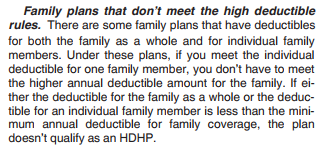Overview
We have established that you cannot contribute to an HSA if you or your spouse has a Flexible Spending Account (FSA). This is because FSA coverage is considered “other health coverage” which prevents one from being HSA eligible. Since FSA benefits extend to the holder as well as their spouse and dependents, this can disqualify some otherwise ready people from contributing to HSA’s. Per IRS form 969:
An employee covered by an HDHP and a health FSA or an HRA that pays or reimburses qualified medical expenses generally can’t make contributions to an HSA
The exceptions to the above quote include limited purpose health FSA or HRA, Suspended HRA, post-deductible FSA or HRA, and retirement HRA.
Carryover and Grace Period defined
Generally, FSA’s are “use it or lose it” type plans where any unused funds disappear at the end of the year. This contrasts sharply with HSA’s where the funds are yours forever. To cushion this blow, the IRS allows for two FSA options available to the plan administrator. Generally only one of the following can be chosen per FSA:
- Grace Period – for 2.5 months following the end of the plan year, you can use prior year funds to pay for qualified medical expenses. This effectively extends the “lose it” deadline. That means up until March 15th you can still use your prior year FSA funds.
- Carryover – your plan may allow up to $500 to be brought forward into the current year to spend on qualified medical expenses. You then have access to this money for the entire year. Any amount above this is forfeit. In other words, you can maintain $500 in your FSA indefinitely.
Can I contribute to my HSA if I carryover FSA funds?
These provisions effectively extend the life of your current year FSA funds. However, a fairly common scenario is ending FSA coverage with a carryover / grace period and beginning HSA eligible coverage. What happens when the FSA carryover interferes with HSA coverage? Are these people HSA eligible, and can they contribute?
HSA with FSA Grace Period
Surprisingly, the IRS provides explicit guidance to the carryover or grace period provision that many FSA’s contain. In IRS form 969 they state:
Coverage during a grace period by a general purpose health FSA is allowed if the balance in the health FSA at the end of its prior year plan is zero.
This is great because it allows an exception to the “no other coverage” clause of HSA eligibility. As long as you zero out your FSA by December 31st, you nullify the carryover or grace period impact and can contribute to your HSA per normal. This provides relief for those whose FSA coverage is ending and HSA coverage is beginning. Of course, if your FSA policy ends and you no longer have access to it, there is no effect on your HSA contribution.
HSA with FSA carryover
The IRS does not call out the FSA carryover provision and how it affects HSA contributions. I believe this is implicit since a carryover constitutes a continued access to FSA funds. If you have FSA funds available, you are not HSA eligible. However, if your FSA coverage ends and wipes out any carryover funds, you would then be HSA eligible, assuming all other conditions are met.
FSA / HSA contribution examples
Here are some common scenarios you might encounter with an FSA carryover or grace period and the effect on HSA contributions. Each scenario assumes you have an FSA in the current year and are switching to an HSA eligible plan in the new year:
- FSA has carryover but no balance on Dec 31st – since you depleted your FSA by year end, you can contribute to your HSA for each month in the following year.
- FSA has grace period of 2.5 months with balance on Dec 31st – since your FSA has a balance on January 1st, you are not HSA eligible until April 1st. This assumes the FSA coverage goes away and additional FSA funds are not made available.
- You carryover $500 in your FSA into subsequent year – you cannot contribute to your HSA while covered by an FSA. As long as your FSA coverage continues and funds remain in your account, you cannot contribute to the HSA. Since the carryover period technically lasts all year, in theory this could make you HSA ineligible for the year.
The bottom line: use up any of your FSA funds by December 31st if you wish to be HSA eligible on January 1st.
Note: to fulfill the IRS requirement of tracking HSA receipts, please consider my service TrackHSA.com for your Health Savings Account record keeping. You can store purchases, upload receipts, and record reimbursements securely online.



